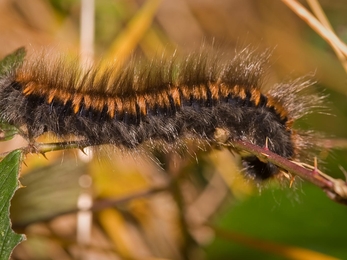The fox moth (Macrothylacia rubi) gets its name from its rich, fox-like colouring. The males are a deep russet brown, with soft, velvety wings marked by two orange-coloured bands that cut diagonally across like old laces on a well-worn coat. These males are strong flyers, often zig-zagging low through vegetation on the lookout for females during the day. The females are larger, cloaked in a duskier brown-grey, and take to the air at night, more secretive in their movements.
But it’s the caterpillar stage that really steals the show. Before they take to the skies, fox moths live for many months as large, boldly banded caterpillars. They can grow up to 7cm long and are covered in thick, dark hairs, almost bristly to the touch. Down their sides run bright orange or tawny stripes that give them a flame-like appearance - something you don’t forget in a hurry.


